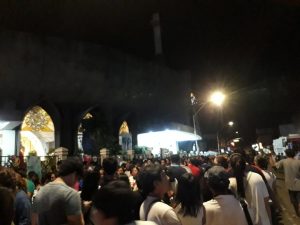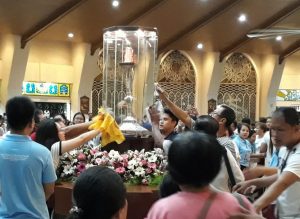
DAVAO CITY – Thousands of Dabawenyos queued for the public veneration of the “incorrupt heart” of Padre Pio that arrived here on Sunday from Cebu City for a four-day visit from October 14 to 17.
Some of the faithful came in wheelchairs, braving the scorching heat of the sun. Others said they are not in particular devotees of Padre Pio, but still came after hearing he can cure cancer.
Padre Pio was canonized by Pope John Paul 11 in 2002 or 34 years after he died in 1968 in the town of San Giovanni Rotondo, Italy.
Padre Pio, whose full name is Francesco Forgione, was born in 1887 in Pietrelcina, Italy and was a known stigmatist and mystic.
The line was long, reaching the other street of Magallanes passing through the City Hall Drive to San Pedro Square where the San Pedro Cathedral is located. Security was tight.
Thousands also gathered at the Ateneo de Davao University-Grade School campus in Matina for public veneration and mass.

Catholic devotees prayed and wiped with white or yellow cloth the glass-encased relic of Padre Pio, which will be in the Philippines for 22-days before its return to Italy.
The public veneration at the Cathedral will only be interrupted by regular mass schedules at 6 a.m., 12 noon and 5:30 p.m. on Monday. The holy relic will be transferred to the Regional Major Seminary (REMASE) in Catalunan Grande for priests and consecrated persons at 8 a.m. on Tuesday and return to the Cathedral in the afternoon.
Dr. Eugenia Hingpit, president of the Saint Padre Pio Prayer Group from Tagum City, said her group were among those that welcomed the arrival of holy relic at the Francisco Bangoy International Airport here.
“We do not want to miss this rare opportunity,” she said.
She added that her prayer group has grown to 50 members since she founded it three years ago. The group holds activities at the Saint Pio Learning Center in Villa Patricia, Tagum City in partnership with the Sisters of the Poor.
Fr. Ilde Dimaano, social communications director of the Archdiocese of Lipa and representative of the National Shrine of Saint Padre Pio in Batangas, said the arrival of the relic is once in a lifetime opportunity for Filipinos.
Dimaano said the Philippines is the fourth country and the first in Asia that the relic has visited. The three others are the United States, Argentina and Portugal.
This year being declared as the year of the clergy and consecrated person, Dimaano said Saint Padre Pio is a good example for Filipinos to emulate.
“In spite of the many political and social problems that we have we are still being asked to be holy at ang kabanalan natin ang magbabago sa atin (our holiness will change us),” he said.
“It is not only prayers but holiness that translates into action, orderliness and moral life and it must be a way of life which he thinks is the message of Padre Pio,” Dimaano added. (Lilian C Mellejor and Digna D. Banzon/PNA)
